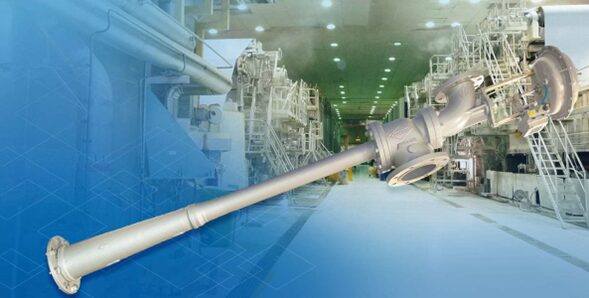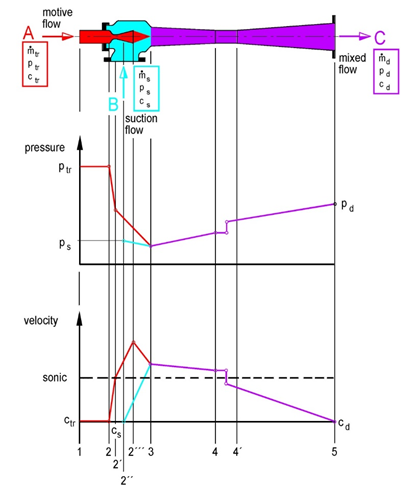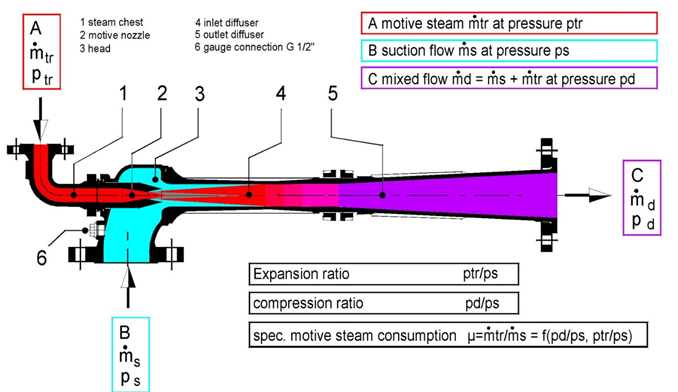Jet Pumps / Ejectors
Jet pumps, Jet Vacuum Pumps, Jet Compressors, Ejectors
Jet pumps, jet vacuum pumps, jet compressors, or ejectors, are sophisticated empirical engineering solutions that utilize the Venturi principle, the reduction in pressure of a medium as its velocity increases when passing through a smaller cross-section, to create effective lower pressure and handle process gases in various industrial applications. When the pressure energy of the motive medium passes a controlled reduction of flow cross-section, a jet with very high velocity and kinetic energy is created and a corresponding under pressure is created, according to the Venturi principle, which sucks in and mixes with the process medium on the suction side. The mixture passes through controlled outlet geometry, in the form of diffusers, to reduce the speed and thus raise the outlet pressure to a pressure higher than the suction pressure, the process medium is compressed, but lower than the pressure of the motive medium. Jet pumps’ motive media can be gases or liquids, such as steam or water. Suction media are usually process gases but can also be liquids or even solid material carried by liquids.
What is a Jet Vacuum Pump, Jet Compressor, or Ejector?
A Steam Jet Pump / Steam Jet Vacuum Pump / Ejector is a type of Jet Vacuum Pump or Jet Compressor, that utilize steam energy as a motive medium to create a vacuum or compress process gases. Steam jet vacuum pumps / Ejectors and Jet compressors use the Venturi principle as described in picture. When using gases, such as steam, as motive medium, very high velocities of the motive medium can be achieved if the passage of the reduced cross-section is followed by a well-dimensioned conical nozzle. In these cases, the motive media can reach supersonic speeds and thus a lower suction pressure, deeper vacuum, or better compression can also be achieved.
Parts of jet pumps / ejectors
A – Inlet for motive media – high pressure
B – Inlets for process gas or liquid – low pressure/vacuum
C – Outlet of mixed motive media and process media – outlet pressure between the pressures at the motive media inlet and the process media inlet
1 – Steam Chest / High-Pressure Chamber – Inlet of high-pressure motive media to the Jet Pump / Ejector
2 – Motive nozzle – controlled reduction of the motive media cross-section passage, if the motive media is a gas or vapor followed by a well-designed conical outlet for supersonic velocity;
3 – Head / Suction Chamber – The high-pressure energy of the motive media is converted into kinetic energy and high speed which, according to the Venturi principle, sucks in surrounding gases, through the suction inlet
4 – Mixing diffuser – Motive and suction media are mixed and the flow velocity decreases while the pressure increases
5 – Outlet diffuser – Motive and suction media continue to mix and the flow velocity further decreases while the pressure increases
Single-stage jet vacuum pumps / ejectors
Single-stage jet vacuum pumps achieve a maximum compression of 1:10, corresponding to a suction pressure from about 100 mBar absolute, vacuum, to an outlet pressure at atmospheric pressure. The design of the jet pumps/ejectors can be optimized to minimize steam consumption.
Other uses for Jet pumps, Jet vacuum pumps, Jet compressors, Ejectors
- Jet compressors
- Thermocompressors
- Steam jet heaters
- Liquid ejectors
- Tank mixing systems – Eductors
- Jet aerators for wastewater aeration
Multi-stage vacuum system – JetVacuumSystem
If a deeper vacuum is needed than what can be achieved with a single-stage jet vacuum ejector, several ejectors can be installed in series. To reduce energy consumption, condensers are also commonly used to condense steam and condensable gases. The earlier, at the lower temperature, the first condensation takes place, the lower the consumption of motive media and often also the total energy consumption.
Applications for Jet pumps, Jet vacuum pumps, Jet compressors, Ejectors
Jet pumps and ejectors are versatile and used in various industries, such as petrochemical, chemical, pharmaceutical, pulp & paper, food processing and wastewater treatment etc. They can be used for processes involving filtration, evaporation, distillation, absorption, mixing, freeze-drying, drying, degassing, thermocompression, etc.
Jet pumps / ejectors are known for their efficiency, reliability and ability to handle a wide range of media types, pressures and temperatures. In many cases, one jet pump / ejector is sufficient to reach the desired process characteristics or vacuum for the process, so-called single-stage systems, in other cases and other process conditions it is needed to install several jet pumps / ejectors in series to reach the desired effect or vacuum, so-called multi-stage vacuum systems.
The industries and sectors that often use jet pumps / ejectors include, among others:
- Biofuels and cooking Edible Oils;
- Chemical industry;
- Food industry;
- Mining and steel industries;
- Petrochemical industry;
- Petroleum refineries;
- Thermal power plants;
- Paper and pulp industry;
Advantages of jet pumps / steam jet vacuum pumps / ejectors
Cost efficiency and low maintenance: With low initial costs and minimal maintenance, our jet pumps are an economically advantageous solution compared to other vacuum technologies.
Flexibility and adaptability: Whether for extraction, evacuation or general vacuum service, our jetpumps can be tailored to meet specific needs and requirements in different industries and sectors. They can handle large gas volumes in relatively small designs.
Simple design and reliable operation: With their simple and streamlined design, with no moving parts to wear out or break, our ejectors offer reliable operation, minimal maintenance and low maintenance costs.
High Operating Reliability: Steam jet ejectors can perform very well and create high-efficiency vacuum conditions even in very difficult operating conditions.
Wide range of construction materials: Steam jet ejectors can be made from virtually any material and therefore a specific corrosion- or erosion-resistant material can be chosen.



